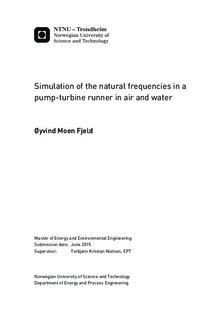| dc.contributor.advisor | Nielsen, Torbjørn Kristian | |
| dc.contributor.author | Fjeld, Øyvind Moen | |
| dc.date.accessioned | 2015-10-05T14:51:16Z | |
| dc.date.available | 2015-10-05T14:51:16Z | |
| dc.date.created | 2015-06-17 | |
| dc.date.issued | 2015 | |
| dc.identifier | ntnudaim:13227 | |
| dc.identifier.uri | http://hdl.handle.net/11250/2350104 | |
| dc.description.abstract | Structural-acoustic models are used in the industry to determine the natural frequencies of runners and impellers in hydraulic turbomachinery under construction of the machines. The structural-acoustic models have to be able to handle the complex boundary conditions and loads experienced. The new trends in water power production have led to new operating regimes for several hydro power plants. More time is spent outside Best Efficiency Point (BEP) and frequent adjustment of output is common. These factors put large stresses on the structure. Especially for high head turbines where forces are high, fatigue loads could cause serious damage after short time of operation. The fatigue loads are amplified if they get into resonance with the natural frequency of the runner. Knowledge of the natural frequencies of a
turbine are therefore of great importance. Structural-acoustic models of the turbine and its surroundings have become an important part of construction tomaximize efficiency and safety. Over the last decade several breakdowns of newly installed turbines have shown that there are challenges to overcome in design, building and operation of these turbomachines. In this report, a CAD model of a pump-turbine runner is used in numerical simulations to investigate its structural behavior and natural frequencies in air and submerged in water. The goal is to find the added mass effect and see how well numerical simulations match experiments done on the exact same pump-turbine runner at theWater Power Laboratory at NTNU. ANSYSMechanical software is used for the simulations. The results obtained inmodal analysis showed a Frequency Reduction Ratio (FRR) in water between 14-34 %, depending on the mode shape. FRR in the harmonic response analysis showed values from 11-20 %. Comparison with the experimental investigation showed large deviations for allmodes except (2,0). | |
| dc.language | eng | |
| dc.publisher | NTNU | |
| dc.subject | Energi og miljø, Strømningsteknikk | |
| dc.title | Simulation of the natural frequencies in a pump-turbine runner in air and water | |
| dc.type | Master thesis | |
| dc.source.pagenumber | 43 | |

